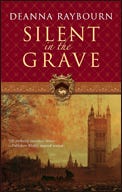Silent in the Grave introduces Lady Julia Grey and Nicholas Brisbane, the most dynamic pair of Victorian sleuths to grace the page since Anne Perry’s Thomas and Charlotte Pitt. In the opening page, as Lady Julia's baronet husband writhes on the white marble floor of their townhouse foyer, she exhorts him: "Edward, we have guests. Do get up."
But Sir Edward is dying (rather dramatically) of what everyone believes is a congenital heart defect. Only Nicholas Brisbane, a private investigator Edward hired to find the person torturing him with veiled threats, suspects murder. Lady Julia wants no part in such suspicions . . . until she discovers one such threat hidden in Edward’s old study. The game is afoot.
Lady Julia is the youngest daughter of the Earl of March, patriarch of a large tribe, "[r]anging from the mildly odd to the wildly eccentric." Julia is distressingly conventional in the eyes of her family and bemoans her own normalcy: "I did not even keep a pet monkey . . . or dye my dogs pink." In the course of the story, we watch Julia shed her black widow’s weeds, befriend Madame de Bellefleur, an infamous London courtesan with a mysterious past, and finally emerge from mediocrity (according to sister Portia, living openly with her lesbian lover) "[a]ll bold colors and alabaster décolletage." In tandem with the swarthy and alluring Brisbane, Julia is now engaged up to her colorful knees trying to solve the mystery of her husband’s death and "juggling secrets like so many conjurer’s balls," not the least of which is the Queen’s Tower raven, which has taken up residence in her townhouse along with several other strange members of the March clan.
If Silent in the Grave is a bit longer than a more conventional detective novel, the reader is compensated by the rich Victorian details fairly dripping off the pages. The mystery is skillfully threaded throughout, leading us on with increasing suspense to the very last page. (2007, 511 pages)





